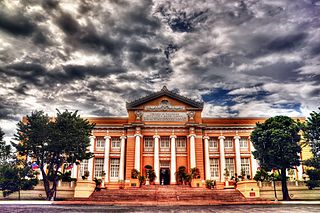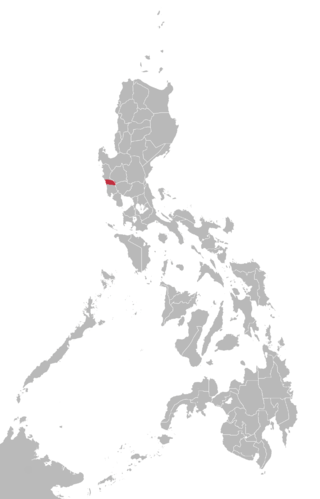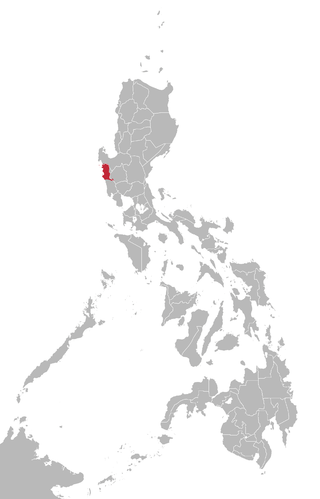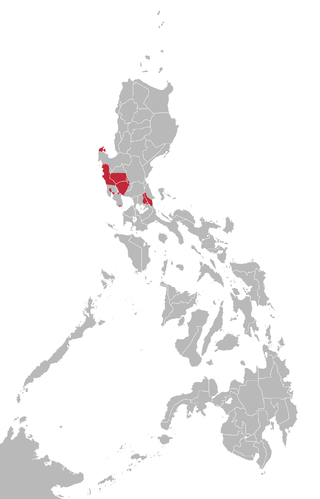
Zambales, officially the Province of Zambales, is a province in the Philippines located in the Central Luzon region. Its capital is Iba, which is located in the middle of the province. Zambales borders Pangasinan to the north and northeast, Tarlac to the east, Pampanga to the southeast, Bataan to the south and the South China Sea to the west. With a total land area of 3,830.83 square kilometres (1,479.09 sq mi), Zambales is the second largest among the seven provinces of Central Luzon after Nueva Ecija. The province is noted for its mangoes, which are abundant from January to April.

Tarlac, officially the Province of Tarlac, is a landlocked province in the Philippines located in the Central Luzon region. Its capital is the city of Tarlac. It is bounded on the north by the province of Pangasinan, Nueva Ecija on the east, Zambales on the west and Pampanga in the south. The province comprises three congressional districts and is subdivided into 17 municipalities and one city, Tarlac City, which is the provincial capital.

Aurora, officially the Province of Aurora, is a province in the Philippines located in the eastern part of Central Luzon region, facing the Philippine Sea. Its capital is Baler and borders, clockwise from the south, the provinces of Quezon, Bulacan, Nueva Ecija, Nueva Vizcaya, Quirino, and Isabela.

The Ilocos Region, designated as Region I, is an administrative region of the Philippines. Located in the northwestern section of Luzon, it is bordered by the Cordillera Administrative Region to the east, the Cagayan Valley to the northeast and southeast, Central Luzon to the south, and the South China Sea to the west.

Central Luzon, designated as Region III, is an administrative region in the Philippines, primarily serving to organize the 7 provinces of the vast central plains of the island of Luzon, for administrative convenience. The region contains the largest plain in the country and produces most of the country's rice supply, earning itself the nickname "Rice Granary of the Philippines". Its provinces are: Aurora, Bataan, Bulacan, Nueva Ecija, Pampanga, Tarlac and Zambales. Pangasinan was formerly a province of Central Luzon before President Marcos signed Presidential Decree No. 1, 1972, incorporating it into Ilocos Region. Additionally, the province of Aurora was part of the defunct political region Southern Tagalog when the region was divided into Calabarzon and Mimaropa, upon the issuance of Executive Order No. 103, dated May 17, 2002, by then-President Gloria Macapagal Arroyo, which transferred Aurora to Central Luzon.

Anda, officially the Municipality of Anda, is a 3rd class municipality in the province of Pangasinan, Philippines. Unique in this part of the province, The Sambalic language of Bolinao or Binubolinao is primarily spoken in the municipality and the adjacent town of Bolinao. According to the 2020 census, it has a population of 41,548 people.

Iba, officially the Municipality of Iba, is a 1st class municipality and capital of the province of Zambales, Philippines. According to the 2020 census, it has a population of 55,581 people.

Pangasinan, officially the Province of Pangasinan, is a coastal province in the Philippines located in the Ilocos Region of Luzon. Its capital is Lingayen. Pangasinan is in the western area of Luzon along Lingayen Gulf and the South China Sea. It has a total land area of 5,451.01 square kilometres (2,104.65 sq mi). According to the 2020 census, it has a population of 3,163,190. The official number of registered voters in Pangasinan is 1,651,814. The western portion of the province is part of the homeland of the Sambal people, while the central and eastern portions are the homeland of the Pangasinan people. Due to ethnic migration, the Ilocano people settled in the province.

Bani, officially the Municipality of Bani, is a 2nd class municipality in the province of Pangasinan, Philippines. According to the 2020 census, it has a population of 52,603 people.

Bolinao, officially the Municipality of Bolinao, is a 1st class municipality in the province of Pangasinan, Philippines. According to the 2020 census, it has a population of 83,979 people.

Infanta, officially the Municipality of Infanta, is a 3rd class municipality in the province of Pangasinan, Philippines. According to the 2020 census, it has a population of 26,242 people.

San Marcelino, officially the Municipality of San Marcelino, is a 1st class municipality in the province of Zambales, Philippines. According to the 2020 census, it has a population of 37,719 people.
The Pangasinan people, also known as Pangasinense, are an ethnolinguistic group native to the Philippines. Numbering 1,823,865 in 2010, they are the tenth largest ethnolinguistic group in the country. They live mainly in their native province of Pangasinan and the adjacent provinces of La Union and Tarlac, as well as Benguet, Nueva Ecija, Zambales, and Nueva Vizcaya. Smaller groups are found elsewhere in the Philippines and worldwide in the Filipino diaspora.

During the Spanish colonial period in the Philippines (1565–1898), there were several revolts against the Spanish colonial government by indigenous Moro, Lumad, Indios, Chinese (Sangleys), and Insulares, often with the goal of re-establishing the rights and powers that had traditionally belonged to Lumad communities, Maginoo rajah, and Moro datus. Some revolts stemmed from land problems and this was largely the cause of the insurrections that transpired in the agricultural provinces of Batangas, Bulacan, Cavite, and Laguna. Natives also rebelled over unjust taxation and forced labor.
Cuyunon refers to an ethnic group populating the Cuyo Islands, along with northern and central Palawan. The Cuyunons hail originally from Cuyo and the surrounding Cuyo Islands, a group of islands and islets in the northern Sulu Sea, to the north east of Palawan. They are considered an elite class among the hierarchy of native Palaweños. They are part of the wider Visayan ethnolinguistic group, who constitute the largest Filipino ethnolinguistic group.
The Sambalic languages are a part of the Central Luzon language family spoken by the Sambals, an ethnolinguistic group on the western coastal areas of Central Luzon and the Zambales mountain ranges.

Botolan is a Sambalic language spoken by 32,867 Sambal, primarily in the Zambal municipalities of Botolan and Cabangan in the Philippines. Language status is 5 (developing).

Sambal or Sambali is a Sambalic language spoken primarily in the Zambal municipalities of Santa Cruz, Candelaria, Masinloc, Palauig, and Iba, and in the Pangasinense municipality of Infanta in the Philippines; speakers can also be found in Panitian, Quezon, Palawan and Barangay Mandaragat or Buncag of Puerto Princesa. The speakers of the language are decreasing due to the fact that many of the speakers are shifting to Tagalog & Ilocano.
Abellen, Abenlen, Aburlin, or Ayta Abellen, is a Sambalic language. It has about 3,500 speakers and is spoken in a few Aeta communities in Tarlac province, Philippines. Ayta Abellen itself is part of the Sambalic language family in the Philippines and is closely related to not only the five other Ayta dialects but also the Botolan dialect of Sambal. Ethnologue reports 45 monolinguists.

The Central Luzon languages are a group of languages belonging to the Philippine languages. These are predominantly spoken in the western portions of Central Luzon in the Philippines. One of them, Kapampangan, is the major language of the Pampanga-Mount Pinatubo area. However, despite having three to four million speakers, it is threatened by the diaspora of its speakers after the June 1991 eruption of that volcano. Globalization also threatened the language, with the younger generation more on using and speaking Tagalog and English, but promotion and everyday usage boosted the vitality of Kapampangan.

















